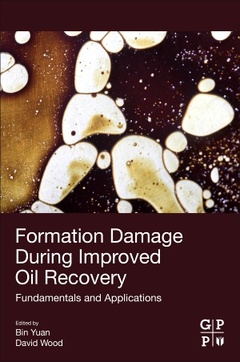Description
Formation Damage during Improved Oil Recovery
Fundamentals and Applications
Coordinators: Yuan Bin, Wood David
Language: English
Subject for Formation Damage during Improved Oil Recovery:
Keywords
<; p>; Oil recovery; low-salinity waterflooding; LSW; secondary recovery; tertiary recovery; produced water reinjection; wax deposition; polymer flooding; surfactant flooding; alkaline; CO2 flooding; CO2 sequestration; thermal; heavy oil; chemical EOR; coalbed methane; unconventional reservoirs; geothermal reservoirs; offshore; deepwater; nanofluid; IOR projects; EOR<; /p>
676 p. · 15x22.8 cm · Paperback
Description
/li>Contents
/li>Biography
/li>Comment
/li>
Formation Damage during Improved Oil Recovery: Fundamentals and Applications bridges the gap between theoretical knowledge and field practice by presenting information on formation damage issues that arise during enhanced oil recovery. Multi-contributed technical chapters include sections on modeling and simulation, lab experiments, field case studies, and newly proposed technologies and methods that are related to formation damage during secondary and tertiary recovery processes in both conventional and unconventional reservoirs. Focusing on both the fundamental theories related to EOR and formation damage, this reference helps engineers formulate integrated and systematic designs for applying EOR processes while also considering formation damage issues.
1. Overview of Formation Damage during Improved and Enhanced Oil Recovery2. Low-Salinity Water Flooding: from Novel to Mature Technology3. Formation Damage by Fines Migration: Mathematical and Laboratory Modelling, Field Cases4. Using Nanofluids to Control Fines Migration in Porous Systems5. Formation Damage by Inorganic Deposition6. Formation Damage by Organic Deposition7. Formation Damage during Chemical Flooding8. Formation Damage Problems associated with CO2 Flooding9. Formation Damage by Thermal Methods Applied to Heavy Oil Reservoirs10. Formation Damage Issues in Unconventional Reservoirs11. Formation Damage Problems in Offshore and Deepwater Reservoirs12. Formation Damage Challenges in Geothermal Reservoirs13. Formation Damage in Coalbed Methane Recovery14. Special Focus on Produced Water in Oil and Gas Fields: Origin, Management and Re-Injection Practice15. Integrated Risks Assessment and Management of IOR/EOR projects: A Formation Damage View
David A. Wood has more than forty years of international gas, oil, and broader energy experience since gaining his Ph.D. in geosciences from Imperial College London in the 1970s. His expertise covers multiple fields including subsurface geoscience and engineering relating to oil and gas exploration and production, energy supply chain technologies, and efficiencies. For the past two decades, David has worked as an independent international consultant, researcher, training provider, and expert witness. He has published an extensive body of work on geoscience, engineering, energy, and machine learning topics. He currently consults and conducts research on a variety of technical and commercial aspects of energy and environmental issues through his consultancy, DWA Energy Limited. He has extensive editorial experience as a founding editor of Elsevier’s Journal of Natural Gas Science & Engineering in 2008/9 then serving as Editor-in-Chief from 2013 to 2016. He is currently Co-Editor-in-Chief of Advances in Geo-Energy Research.
- Presents the first complete reference addressing formation damage as a result of enhanced oil recovery
- Provides the mechanisms for formation damage issues that are coupled with EOR
- Suggests appropriate preventative actions or responses
- Delivers a structured approach on how to understand the fundamental theories, practical challenges and solutions




